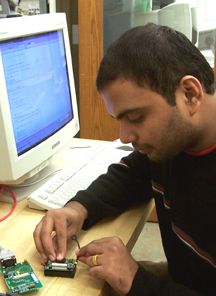KU's ITTC Collaborates on National SensorNet Project

KU's Information and Telecommunication Technology Center has joined forces with Oak Ridge National Laboratories (ORNL) in developing a comprehensive sensor management system. The U.S. Department of Energy's largest science and energy laboratory is directing the creation of a nationwide sensor network -- "Unified Architecture for SensorNet with Multiple Owners" project -- that will identify and assess chemical, biological, radiological, nuclear and explosive (CBRNE) threats. SensorNet will process and disseminate critical information to emergency management decision makers and first responders.
Many ORNL partners are working on a wireless network that interconnects sensors and conveys data to a collection point. Principal investigator Gary Minden, professor of electrical engineering and computer science and director of ITTC's Communications and Networking Systems Laboratory, and his team are working on a different facet of SensorNet. Their goal is to develop a rapidly deployable sensor network with elements that are controlled by different organizations.
Such a system would bring value to a variety of situations including a venue such as the Kansas Speedway, where different organizations are charged with the safety and security of the racetrack, participants, and fans. NASCAR events bring tens of thousands of fans to the track, but the intermittent nature of these events requires that subcontractors handle security, parking, wireless Internet and other services. Currently, the technological foundation does not exist to effectively integrate intelligence from these independent groups. Linking cameras, sensors and communication between Speedway personnel could alert staff to possible incidents that may jeopardize safety. Likewise, a number of public service organizations are involved in traffic control, medical support, firefighting, and utilities and need to be kept current on appropriate events during the five to six days of the race.
ITTC researchers will study low-cost sensor nodes in addition to the wireless interconnected network and the overall service architecture. These nodes - tiny, ubiquitous, networked sensors - possess data processors allowing them to perform simple computations, such as chemical detection and video transmission. The partially processed data can be sent to an on-site headquarters for additional analysis.
Minden's team will develop and deploy a simple system to understand how SensorNet works in the field.
Learn more about ITTC.